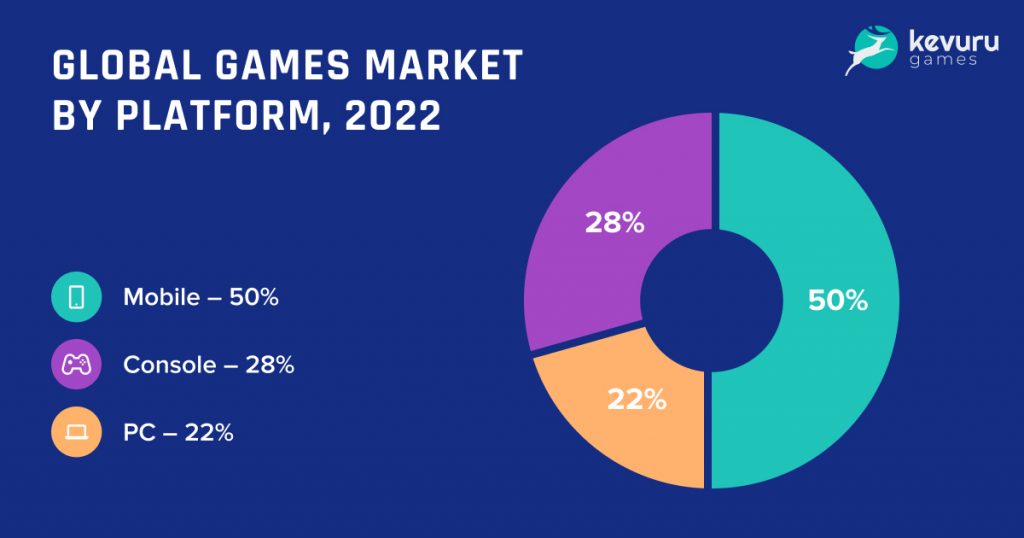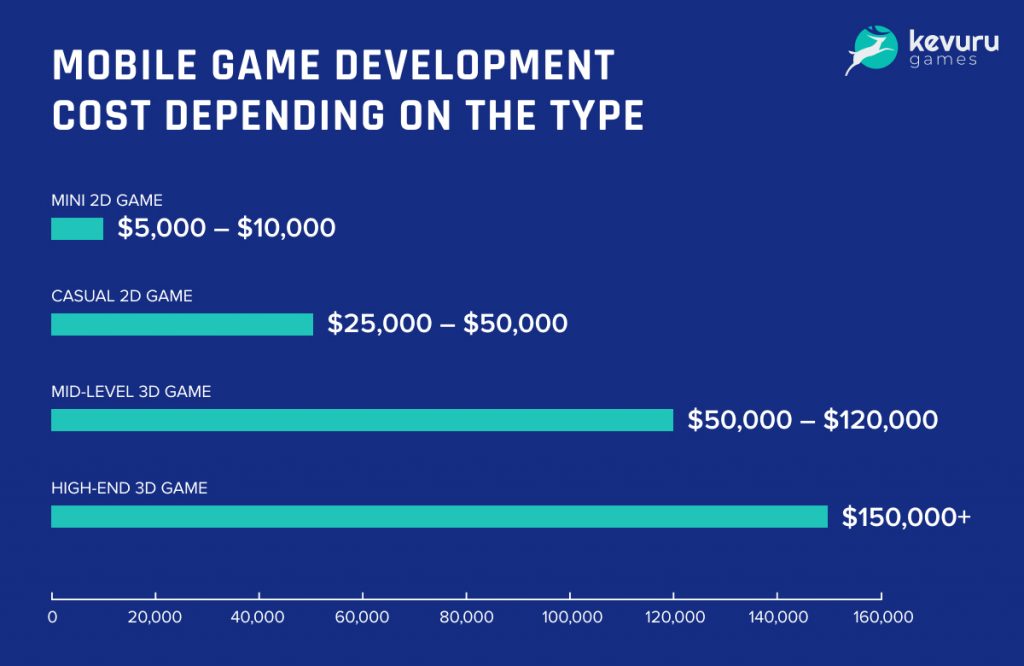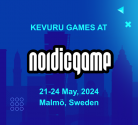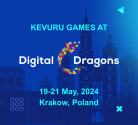First, let’s once again give credit to the large and ever-expanding segment of mobile games. It has long overtaken PCs and consoles, which will not be able to catch up with it even if they merge – a share of 50% speaks for itself.

Almost every person today has a smartphone, which means there is open and hassle-free access to millions of games. Making mobile games is faster and less expensive than developing large titles for consoles and PCs, and the mobile audience is much broader and more supportive of even the simplest and seemingly primitive hyper casual games. But there is one but.
You are not the only person who has noticed all this.
The huge boom in mobile games has made their development a tidbit for many who want to hit the big jackpot as quickly as possible. This has created fierce competition and a market glut with nearly identical entertainment products that attempt unsuccessfully to replicate the most successful pioneers of various genres.
Seeing that they are offered more than they ask, the players have become much more demanding and capricious. Now they are ready to make a verdict on the game for the first 10 seconds of gameplay, and it can no longer be changed.
Without understanding what players need, you can create dozens of games one after another and spend huge budgets, but none of them will bring you the desired results. Disillusioned with mobile development, you simply walk away, leaving your competitors to celebrate.
But it certainly won’t happen today.
Today in this article we will tell you how to make a game app that can work its way into the eyes of players through hundreds of analogues. We will tell you the secrets of building a game app with the most relevant and interesting design for players. We will tell you about the best monetization models, the cost of creating a game application and, of course, choosing the best provider to create a game.
Let’s start, there is a lot to do.
How To Make a Mobile Game App: 12 Developemnt Steps
Creating a successful mobile game app requires careful planning, creativity, and attention to detail. The mobile gaming industry is highly competitive, with thousands of new games being released regularly. To stand out amidst this competition, developers must meticulously plan their game’s concept, mechanics, and marketing strategy to attract and retain players. Let’s explore the essential steps involved in developing a mobile game app, starting with the inception of a superb game idea:
Have a Superb Game Idea
Finding a superb game idea involves a combination of creativity, observation, and problem-solving. Here are some strategies to help you discover compelling concepts for your next mobile game:
- Start by reflecting on your own interests, hobbies, and passions. Consider topics or activities that excite you and explore how they could be translated into engaging gameplay experiences.
- Pay attention to your surroundings and daily experiences for inspiration. Everyday activities, stories, or challenges can serve as the foundation for unique game mechanics and narratives.
- Play various games across different genres and platforms to gain insights into successful gameplay mechanics, storytelling techniques, and design elements. Analyze what works well and consider how you can put your own spin on it.
Research Three Technical Sides of Mobile Development: What You Should Know About
Before diving into the classic twists and turns of ideas, genres, target audiences, and platforms, it’s important to understand some key points.
Firstly, the technical side of development. Before making a game app, you need to decide on the engine. Note that not all engines allow you to deploy the same code to multiple platforms. So you need to understand in advance what operating system your programmers are running on. Engines such as Unity, Corona, and Cocos2d are cross-platform.
Dive Deeper:
✔ Cross-Platform Game Development: When Versatility Matters
Secondly, the technical side of testing. To guarantee the viability of your app, the best option would be to test it on several smartphones of different generations. Not all people have cutting-edge devices that have just hit the market. Many people use one smartphone for about 5 years and this should be taken into account.
Thirdly, the technical side of publication. You can’t just go to Google Play and the App Store and say “hello, here’s my application, host it, and I will receive income from monetization.” Stores have their own policies for accepting and approving apps. There are special rules that you will be familiar with. Also, to publish in these stores, you need to purchase developer accounts, thanks to which you will get access to various goodies like the SDK. App Store subscriptions come with an annual price of $99, and Google Play charges a one-time payment of $25.
Choose Types of Mobile Engines
The engine is the foundation that provides the tools and capabilities to build on any designs to create a game app. We can conditionally distinguish three types of game engines:
- Drag-and-drop game engines. Often these engines are about so-called drag-and-drop interfaces where the right elements are moved to the right places with one click. They are great for beginner programmers as they allow them to avoid a lot of cumbersome code. At the same time, the games created can be complex and colorful and not at all primitive. For example, Blueprints visual scripting from Unreal Engine gives you the ability to manage all the gameplay elements without writing a single line of code. GameMaker and GameSalad are other examples of such engines.
- Visual scripting game engines. This is another category that allows developers to avoid complex code work. The point is that they create a kind of graph by dragging and dropping nodes into it that display the necessary logic and actions taking place in the game. Thanks to this approach, even designers can independently test their ideas and make changes to the project. Everyone’s favorite Unity, as well as Game Maker and Construct 3, fall into this category.
- Coding-based game engines. You can also always choose to code your game from scratch. This is the most difficult option, as the programmers will have to do every little detail themselves. But the result, with a successful outcome, can exceed all expectations, since the game will be absolutely unique. The most popular languages among game developers today are C++, C#, and Java. Sometimes Python and PHP are also used to implement specific elements of game code.
Since we are talking about how to create a game app, we cannot ignore the indication of the absolute leader in the direction of the engines. At this stage, no engine has managed to knock Unity off its pedestal. It is considered one of the best game engines in the industry. Unity currently supports over 50% of mobile games and 60% of all AR and VR content.
Dive Deeper:
✔ Unity − What Makes It the Best Game Engine?
Types of Gaming Applications in General and Those You Should Pay Attention To
There is a special classification of game types in Google Play and the App Store, which allows players to better navigate the genres they are interested in. Google Play has 17 categories of games:
- Action.
- Adventure.
- Arcade.
- Board.
- Card.
- Casino.
- Casual.
- Educational.
- Music.
- Puzzle.
- Racing.
- Role Playing.
- Simulation.
- Sports.
- Strategy.
- Trivia.
- Word.
In the App Store, they are slightly different and there are 18 of them:
- Action.
- Adventure.
- Board.
- Card.
- Casino.
- Casual.
- Dice.
- Educational.
- Family.
- Music.
- Puzzle.
- Racing.
- Role playing.
- Simulation.
- Sports.
- Strategy.
- Trivia.
- Word.
The variety of genres often confuses the developer’s mind – which one to choose, which one is more popular, which one resonates best with the players? Statistics for 2022 show such genre leaders as Puzzle and Arcade.
Since the classification of stores lacks the division of casual and hyper casual games, they are considered one category. However, it is important to note that it was hyper casual games that led their category to an unconditional victory over all other genres.
In our detailed research of hyper casual games, we have already said that 2020 was a record-breaking year. In the first quarter, in March alone, the number of installations of hyper casual games in the world grew by 103%, and the session length – by 72%. Keep in mind that this was the start of another impressive year – hyper casual games made up 78% of all mobile game downloads in 2019. The hyper casual market is worth over $2 billion and has brought 100 million new mobile gamers to the gaming ecosystem.
Dive Deeper:
✔ About Profitable Hyper Casual Games: Design Tips, Rates, and Upcoming Trends for 2022
Casual, Lifestyle, and Simulation will be the top gaming options in 2023, as we’ve already talked about in our extensive study of game design trends for the current year. Remember how popular puzzle games like Sudoku or Dots are and how hard it is to turn down arcade games like Angry Birds and Fruit Ninja.
Dive Deeper:
✔ Game Design Trends That Will Rock 2023: Main Factors Shaping the Further Development of the Gaming Industry
The revenues of the developers of the most popular games are amazing.
- For example, Tencent, the creator of PUBG Mobile, one of the top downloads of 2020 and top mobile game by income, has earned over $2.6 billion from its highest-grossing mobile game worldwide for 2020.
- Honor of Kings from the same Tencent almost caught up with its counterpart with almost $2.5 billion spent by players.
- The legendary puzzle Candy Crush Saga, which has been on the market for over 10 years, brought its developer King over $470 million in 3 quarters of 2020.
Find Strong Team For Mobile Game Development
Even one person can make a kind of game in one day. But do you really need this? After all, we are here to discuss serious pressing issues – we are creating a game that will stand out and be profitable.
So, what should be the composition of the team in order to infuse the game with all the necessary juices?
Game Designer
This person thinks over the whole game concept. He or she draws up a special game design document where absolutely all the details regarding the future game are prescribed. There are a huge number of areas of responsibility:
- game world;
- characters;
- game mechanics;
- dialogues;
- plot;
- scripts;
- quests and tasks;
- gameplay;
- rules and restrictions;
- victory and defeat conditions;
- user interface, etc.
Sometimes game designers are divided into separate teams responsible for one of the above areas. The lead designer coordinates the work of everyone else and polishes the final version of the game design document in order to approve it with the customer.
Dive Deeper:
✔ Game Designers Backstage: Rates, Mistakes, and Victory Conditions [+ Detailed Game Design Document Template]
Artist
If the designer thinks over the idea, then the artist visualizes it. There are 2D and 3D artists whose workflows differ due to the different approach to creating 2D and 3D graphics. 2D artists are most often involved in concept art, environments, sprites, and user interface. 3D artists are focused on creating 3D models of characters and assets. But the objectives can vary depending on the goal. This category also includes animators who bring the drawn art to life and bring dynamics to it. The team of artists is led by an art director who makes sure that their work matches the game design document.
Dive Deeper:
✔ 2D and 3D Art Cost: Universal Formula for a Quick Estimate [+Built-in Instant Price Calculator]
Developer
Not to be confused with the definition of the entire development company. The developer or programmer is a person who makes a game playable. This team deals with the logic of the game and turns a set of visual components created by artists into an interactive world where the player can create anything and reap the consequences of their actions. Programmers can also be divided into categories, each of which is responsible, for example, for physics, gameplay, or network communications. The team leader will make sure that all the disparate components can ultimately be combined into a harmonious canvas.
Dive Deeper:
✔ 6 Key Stages of Game Development: From Concept to Standing Ovation
Sound Engineer
Sound designers are responsible for sound effects. They make sure that the right sounds correspond to certain actions or events in the game. It may seem that this is not so important and the players do not pay attention to the sounds, but if the slightest problem or dissonance arises, it will immediately come to the fore. As for the game soundtrack, this is usually done by a dedicated composer who is hired separately through an outsourcing scheme.
Tester
The finished game could have been an unexpected surprise for the team, if not for the testers. Their task is to protect players from possible errors and shortcomings that have arisen during development. They carefully check the entire game up and down, document defects in a timely manner, check compatibility, localization nuances, and much more. Their verdict is the final point, after which the game reaches the players.
Project Manager
Despite the fact that we have already listed the core of the team, it would be unfair not to mention the project manager. Most often they are also involved in the development of the game since they are the link between the customer and all teams. They oversee all processes, form milestones and structure work processes so that intermediate results are in line with the set deadlines. The absence of a project manager can significantly delay the process, because if no one is breathing down the necks of artists and developers, they may start working a little slower than they could.
Build an Engaging Story
Crafting a compelling narrative is crucial for immersing players in your mobile game app. Follow these steps to build an engaging story:
- Develop Characters: Create relatable and memorable characters with distinct personalities, motivations, and backgrounds.
- Construct Plot: Design an intriguing storyline with compelling conflicts, challenges, and plot twists that drive player engagement.
- Utilize Storytelling Devices: Incorporate storytelling devices such as dialogue, cutscenes, and narrative arcs to enhance the player experience.
Make a Rock-Solid Game Plan
A solid game plan is essential for guiding the development process and ensuring its success. Here’s how to create one:
- Set Objectives: Define clear objectives and goals for your mobile game app, including target audience, platform, and monetization strategy.
- Establish Timeline: Create a realistic timeline with milestones and deadlines for each stage of development, from concept to launch.
- Allocate Resources: Determine the resources required for development, including budget, team members, and technology tools.
Types of Gaming Applications in General and Those You Should Pay Attention To
Understanding different types of gaming applications and emerging trends can help you create a successful mobile game app. Here are some categories to consider:
- Casual Games: Simple, easy-to-play games suitable for short play sessions, such as puzzle games or arcade-style games.
- Strategy Games: Games that require strategic thinking, planning, and decision-making, such as simulation games or real-time strategy (RTS) games.
- Augmented Reality (AR) Games: Games that blend virtual elements with the real world using AR technology, offering immersive and interactive experiences.
Create a Game Design Document
A Game Design Document (GDD) serves as a blueprint for your mobile game app’s development. Here’s what to include:
- Concept Overview: Describe the game concept, including its genre, theme, and target audience.
- Gameplay Mechanics: Outline the core gameplay mechanics, controls, and interactions that players will experience.
- Art Style and Assets: Define the visual style, art assets, and sound design elements that will be used in the game.
Design the Game Structure
Creating the framework for the game’s organization and player experience is part of the game structure design process. Consider the following aspects:
- Level Design: Plan the layout and progression of levels, including difficulty curves, obstacles, and rewards.
- Progression System: Implement a progression system that motivates players to continue playing and advancing through the game.
- User Interface (UI): Design intuitive and user-friendly UI elements, menus, and screens for navigation and interaction.
Make a Playable Prototype
Developing a playable prototype allows you to test and iterate on your game concept before full-scale development. Here’s how to create one:
- Focus on Core Gameplay: Prioritize the implementation of core gameplay mechanics and features to showcase the game’s potential.
- Gather Feedback: Solicit feedback from testers and stakeholders to identify areas for improvement and refinement.
- Iterate and Refine: Continuously iterate on the prototype based on feedback, making adjustments to gameplay, controls, and user experience.
Design and Develop Your Mobile Game
With a solid plan in place, it’s time to bring your mobile game app to life through design and development:
- Art and Assets: Create high-quality artwork, animations, and sound effects that align with the game’s theme and style.
- Coding and Programming: Use game development tools and programming languages to code the game mechanics, logic, and functionality.
- Optimization: Optimize the game for performance, compatibility, and user experience across different mobile devices and platforms.
Mobile Game Testing
Thorough testing is essential to ensure that your mobile game app functions as intended and provides an enjoyable experience for players:
- Functional Testing: Test all aspects of the game, including gameplay mechanics, controls, and user interfaces, to identify and fix any bugs or issues.
- Compatibility Testing: Verify that the game runs smoothly on various devices, screen sizes, and operating systems.
- User Feedback: Gather feedback from testers and players to assess overall satisfaction and identify areas for further improvement.
Don’t Miss the Profits: Monetization Strategies For Mobile Games
Successful monetization is a delicate job, similar to the work of a jeweler. Aggressive or, conversely, passive methods of promoting paid features lead to a drop in gamers’ interest in the game or lost profits. Much depends on the optimization model.
If you decide to design a game app, then you should know that mobile apps have several monetization paths. There is no precise and approved classification, but the following directions can be distinguished:
- Freemium. The bottom line is that the basic features of the application are provided for free, and for the advanced ones you need to pay extra. Most often, advanced levels or additional missions are provided as extensions. This model usually does not give players the opportunity to complete the game without completing a single transaction. In this model, it is very difficult to balance the functionality and game mechanics so that the players are interested in buying and do not produce negativity for the fact that the game does not allow them to fully enjoy it without constant reminders of the possibility of buying something.
- Free-to-play. This is the most requested business model in mobile gaming. At the moment, it accounts for 90% of the market revenue. As part of free-to-play, players gain access to all game levels, but the gameplay includes in-app purchases that make it easier to complete the game. The big advantage of the free-to-play model is that such payments are optional. This keeps players loyal and helps popularize your app.
- Premium. This is a model in which for unlimited game possibilities you need to pay a fixed amount in the store. This model is popular among business applications and educational programs, but in the gaming industry, it generates less than 10% of the revenue in the mobile market. The reason is simple: a large number of users are not willing to pay for a game before they are convinced that it is worth it. Therefore, this model is more often used by large brands, whose name guarantees the quality of the manufactured product.
- Advertising. A popular model for hyper casual games. Users of applications with embedded ads pay for the extended functionality with their own time – the application offers an in-game bonus for watching the video. The advantage of this approach is the relative technical ease of implementation and the fact that users are used to ad integrations on other services and are tolerant of a moderate amount of such content in the application.
- Subscription. The user pays a certain amount once a month/year and gets access to all game content for this period. The model is popular for services that integrate into the daily life of users – music services, access to software, educational or entertainment content. In the gaming industry, the subscription model is suitable for loyal gamers and games that are able to retain users for a long time.
Many developers use several monetization models at once so that different segments of players can be profitable. For example, someone views an advertisement, and someone pays to turn it off. Someone unlocks an improvement in the game by watching a commercial, and someone prefers to buy it.
How Much Does It Cost to Develop a Mobile Game? Estimated Prices & Examples of Famous Titles
We have already discussed the cost issue of building a game app in one of our previous articles fully devoted to factors affecting prices and clear estimates. Let us briefly recall what stages the development consists of, how long it will take and how much it will cost.
Factors affecting the price and clear estimates for casual, mid-level, and hardcore mobile games
Learn moreSo, gaming app development often includes the following stages:
| Stage | Description | Terms |
| Market research | You define your target audience and competitors | 1 week |
| Game design document | It describes all aspects of the future game from platform and storyline to monetization and online opportunities | 1 week |
| Platform selection | You need to decide whether to choose iOS, Android, or a cross-platform option, as well as game mechanics | 2 weeks |
| Prototyping | This is a rough draft of the game without art, allowing you to assess the vitality and fun of the gameplay | 1 week |
| Art creation | Artists draw 2D/3D assets, characters, and environments, work on the interface, and form the visual image of the game | 3 weeks |
| Development | Programmers make the game playable by introducing graphics and other necessary elements | 2+ months |
| Sound design | Creation of sounds and music | 1 week |
| Testing | Troubleshooting and detecting bugs | 1 week |
| Publication | Hosting a game on the Google Play Store or App Store | 1 day (Google Play), up to 1 week (App Store) |
On average, development takes 4 months, while complex projects can take 6+ months.
The cost is influenced by many factors, in particular, the platform, Android vs iOS development type and functionality, the professionalism of the performer, testing and marketing policy, etc.
Note that it costs 10-20% more to develop a game for iOS than for Android. So if your priority is to answer the question of how to make an iPhone game app, then be prepared to pay more. Why is such an injustice even here in mobile app development?
Working with the iOS system is more expensive due to the integration of the payment system and the admin panel, as well as due to a large number of restrictions on applications allowed in the App Store. Thus, if an Android game costs $25,000, its iOS counterpart will cost about $30,000.
Dive Deeper:
✔ Android vs iOS Game Development: Which Platform Runs the Show in 2022?
The approximate cost of developing different types of mobile games is shown in the table below.

It will not be difficult for an experienced company to estimate the price of your game. Kevuru Games knows how to make a game app for iPhone and how to build a game app for Android so that players don’t want to stop playing. Our team has developed 50+ mobile games of various genres, from match-three to quests, and is well-versed in modern trends and players’ expectations. Drop us a few words and we will quickly and accurately calculate the cost of your future game.

A few words about the big titles you know and the cost of their development.
The world-famous colorful birds from the game for Android and iOS Angry Birds, invented by the Finnish company Rovio, were created in 9 months and cost $140,000. The game topped the App Store charts for over a year and ended up making nearly $70 million in sales including stuffed toys and other merchandise. At the moment, the application continues to be modernized, gaining new functionality and captivating players. Considering that the first game was released in 2009, such skillful retention of an interest in such a competitive environment is respectful.
More complex games involving augmented reality like Pokémon GO will cost more. It took over 2 years and $600,000 to create the game. Released in 2016, the game has generated over $4 billion in revenue since its inception, with $1 billion in 2020 alone. It is also the #3 mobile game in terms of money spent by players in 2020, which once again demonstrates the power of constant updates, exciting events, tracking factors that can affect game performance, and fast action to stay on top.
How to Choose a Mobile Game Development Company?
Choosing a bad contractor is a waste of time and money. And among a large number of people willing to sell their services to you, the problem of choice may be much more acute than you expected. But we will not leave you here either – grab 5 tips that will help you to make a mistake:
- Mobile development experience. You must view the experience through the lens of mobile development. The studio should have a separate section dedicated to this service, a detailed description of it, a list of platforms with which they work and the composition of the team that deals with mobile games. Pay attention to the number of years on the market – the older the company, the more it has seen and the more it will be able to offer you.
- Mobile development portfolio. The company can talk about itself in words as much as it wants, but the most eloquent will be its portfolio of mobile projects. Look at what the team has already worked with, what genres they know firsthand, how it approaches the implementation of graphics, game mechanics, monetization, and more.
- Mobile development cost. An experienced company with a portfolio of mobile projects will be able to make a rough estimate of the cost of your project during the day. The figure should not be too low, because most likely it will mean poor quality. But the inflated amounts are also suspicious: be sure to find out on the basis of what the company is asking for a price above the market average.
- Mobile development terms. Be prepared for the fact that a good result does not come quickly. A large team will work on your project with a clear structure and sequence of necessary procedures. If you get a suspicious response like a month or less to a question about the timing, think about how the team is going to accelerate so much. Maybe by depriving your game of important functionality or by using pre-built constructors to create games.
- Mobile development communication. A company worthy of your project can provide clear and clear communication. You will immediately understand this at the first contact when you explain to the team what exactly you want and what are the features of your future game. Interest, clarifying questions, interesting suggestions met and the ability to concisely and concisely formulate the most important thing are important indicators of your contractor’s management and communication abilities. You can also learn a lot from previous customer reviews: there is often useful information there.
At Kevuru Games, we have been engaged in mobile development for over 11 years and we understand well the requirements and desires of the players. We know an unconventional, fresh, and authentic answer to the question of how to create a mobile game and we are ready to share it with you if you are ready to create beyond the limits.
Even though it’s getting harder to please players, we always have a few secret tricks and tactics that will allow us to make a game with simple uncomplicated mechanics a real spectacle for the eyes, mind and hands. We will advise, help, prompt and implement – do not postpone the implementation of your project until tomorrow, because tomorrow we can start implementing it.









